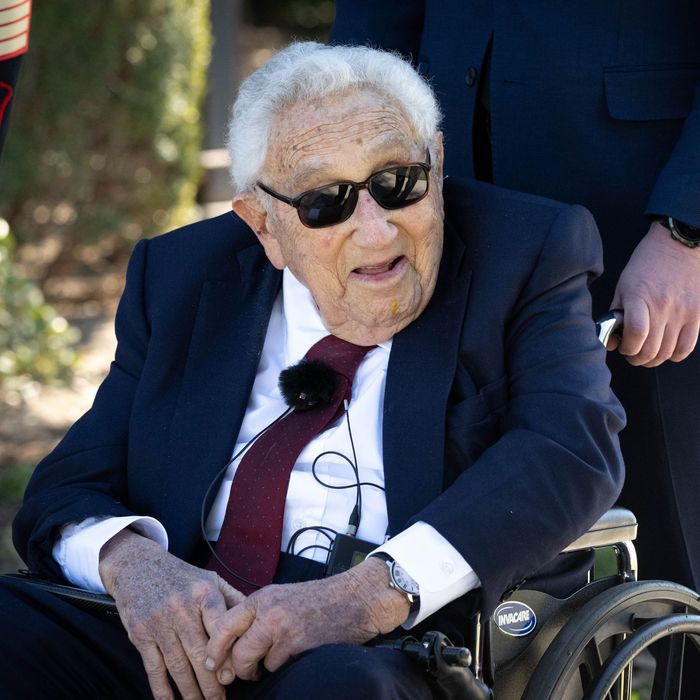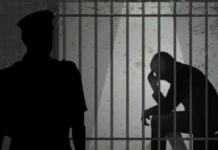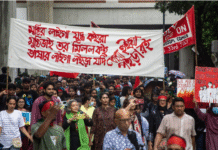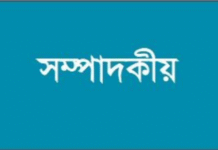
June 27, 2023 Just Security
The epithet most frequently hurled at Kissinger is “war criminal.” The celebrity chef Anthony Bourdain famously wrote, “Once you’ve been to Cambodia, you’ll never stop wanting to beat Henry Kissinger to death with your bare hands … and you will never understand why he’s not sitting in the dock at The Hague next to Milošević.”
So, is Henry Kissinger a war criminal?
It’s difficult not to confuse political, moral, and historical responsibility for great human suffering with criminal liability. But it’s one thing to say that Kissinger’s policies led to hundreds of thousands, probably millions, of deaths. It’s another to say that, in a strict legal sense, he may be responsible for those deaths. But there is a way to make a case using traditional international criminal law principles.
Cambodia is indeed the most obvious example. Did Kissinger order unlawful acts in the bombing of that country? By the early 1970s, a rule requiring that attempts be made to spare civilians was firmly entrenched as a norm of customary international law, based on the concepts of distinction between military and civilian targets and of proportionality, which had been elaborated in international conventions, U.N. General Assembly Resolutions (such as Resolution 2444 of 1969, reaffirming the duty to distinguish between civilians and military targets), U.S. military law, and other efforts to codify the customary norms of humanitarian law. Additional Protocol I of the Geneva Conventions, which came into force in 1977, codified in treaty form many of these customary international legal principles.
In a war that Kissinger and Nixon treated as a “sideshow” to Vietnam, the United States destroyed Cambodia’s neutrality and overthrew its government in an attempt to deny the North Vietnamese sanctuaries and supply lines. But by December 1970, an intense bombing campaign (which already caused massive civilian casualties) and a joint U.S.-South Vietnam ground invasion had failed to root out the Vietnamese communists, and Nixon now wanted to covertly escalate the air attacks. Nixon called Kissinger and told him, “I want a plan where every goddamn thing that can fly goes into Cambodia and hits every target that is open … crack the hell out of them.” Five minutes later, Kissinger called Alexander Haig, then his military assistant, to relay the orders. “He wants a massive bombing campaign in Cambodia. He doesn’t want to hear anything. It’s an order, it’s to be done. Anything that flies, on anything that moves. You got that?” Pentagon records show that, compared with November 1970, the number of sorties by U.S. gunships and bombers in Cambodia had tripled by the end of December.
Kissinger’s order to strike “anything that moves” would appear to call for committing war crimes by ignoring the distinction between military and civilian targets.
Although Kissinger as national security adviser and secretary of state was not in the defense chain of command, there is substantial evidence from the principals’ memoirs (including Kissinger’s: “we worked out the guidelines for the bombing of the enemy’s sanctuaries”), that Kissinger was involved in target selection and “was reading the raw intelligence.” Ray Sitton, a colonel serving the Joint Chiefs of Staff, would bring a list of targets to Kissinger for approval. “Strike here in this area,” Kissinger would tell him, and Sitton would backchannel the coordinates into the field, circumventing the military chain of command. At least 100,000 Cambodian civilians were killed in the bombings. These were not all on Kissinger’s watch, but a recent Intercept investigation – including on-the ground interviews with survivors and formerly classified U.S. military documents from a secret Pentagon task force that investigated war crimes during the 1970s – offers previously unpublished evidence of civilian deaths and shows how he bears responsibility for more violence than previously reported. The records show that U.S. troops implicated in killing civilians received no meaningful punishments. Ultimately, the U.S. bombings drove ordinary Cambodians into the arms of the Khmer Rouge who would take over the country and carry out one of the worst mass atrocities in history.
Pakistan/Bangladesh offers another example. There, Kissinger could be questioned for his role in aiding and abetting Pakistan’s atrocities during the civil war in 1971, which killed hundreds of thousands of East Pakistanis and forced 10 million to flee to India. Under international criminal law, the crime of “aiding and abetting” consists of two elements: the actus reus, and mens rea. The precise standards of these two requirements have developed over time, with almost each international criminal jurisdiction adopting slightly different rules. In general, the actus reus element is satisfied when the accused gives “practical assistance, encouragement, or moral support which had a substantial effect on the perpetration of a crime.” The ad hoc tribunals considered that the mens rea standard was met when the accused “had knowledge” that his acts “would assist the commission of the crime by the perpetrator” or be aware “of the substantial likelihood,” while the International Criminal Court (ICC) requires that the accused act with the “purpose” of facilitating the principal crime.
The civil war began when the supposedly outgoing military ruler of Pakistan, General Agha Muhammad Yahya Khan, launched an attack on the eastern Bengali half of the country (subsequently Bangladesh) following an election victory by the independence-minded Bengali leader Sheikh Mujib-ur-Rahman. Pakistan’s military, dominated by western Punjabis, received some 80 percent of its weapons from the United States and depended on the United States for ammunition and spare parts to keep it operating.
State Department staff in Dhaka, the principal city of East Pakistan, witnessed the violence in which the Pakistani military strafed villages, targeted Hindus (who composed 10 percent of the population), and raped tens of thousands of women. Their reports to Washington relayed the slaughter in gruesome detail and pressed for action to stop the violence, but they were ignored. As described by Princeton professor Gary Bass in his book, “The Blood Telegram: Nixon, Kissinger, and a Forgotten Genocide,” Archer Blood, the U.S. consul general in 1971 in Dhaka, and 20 of his staff, in desperation, sent a “dissent cable,” accusing the administration of “moral bankruptcy” and demanding action to stop the “genocide“ in order “to salvage our nation’s position as a moral leader of the free world.” Kenneth B. Keating, a former Republican senator from New York then serving as the American ambassador to India, personally confronted Nixon and Kissinger in the Oval Office about “a matter of genocide.” Nixon and Kissinger would not have it, however. They ousted Blood – who Kissinger privately scorned as a “maniac” – from his post in East Pakistan, while Nixon called Keating “a traitor.” Not only did the pair despise India and Indira Gandhi, who had sided with East Pakistan (White House tapes reveal Nixon telling Kissinger that the Indians needed “a mass famine.” Kissinger mocked people who “bleed” for “the dying Bengalis”), but they were relying on Yahya as their backchannel for the upcoming breakthrough visit to China. When he returned from his first secret trip to Beijing, Kissinger reported back to Nixon on Pakistan’s help and joked that “Yahya hasn’t had such fun since the last Hindu massacre!” Thus, Kissinger certainly knew of Pakistan’s crimes as they were being committed.
Rather than seeking to restrain the Pakistani military, however, Nixon and Kissinger knowingly broke U.S. law by approving (and concealing their approval of) the transfer to Pakistan of American-supplied F-104 Starfighter bombers from Jordan and Iran.
As Bass’ book makes clear, Kissinger then resisted growing calls to criticize Pakistani behavior or to suggest that Pakistan refrain from using U.S. arms against civilians in East Pakistan. “A month into the slaughter, the Nixon administration firmed up Pakistan policy in the quiet of the oval office. Kissinger urged the president to continue support for Yahya, with only a little retreat.” That “retreat” was a decision to allow spare parts to continue to flow but to hold off new shipments of certain “‘controversial’ items in order not to provoke the Congress to force cutting off all aid.” On Kissinger’s explicit suggestion, Nixon also added a handwritten commentary to the memo that would be distributed internally: “To all hands. Don’t squeeze Yahya at this time.” He underscored the word “Don’t” three times.
The actus reus requirement for Kissinger’s “aiding and abetting” would appear to be satisfied by the military assistance provided to Pakistan, particularly the Starfighter bombers after the slaughter was underway (see ICC Statute Art. 25 (3)(c), where “abetting” includes “providing the means for the commission of crimes”).
Perhaps the most similar case is the Special Court for Sierra Leone’s conviction of former Liberian president Charles Taylor for aiding and abetting the rebels in neighboring Sierra Leone as they committed horrific abuses against civilians. The Court found that Taylor knew of the atrocities being committed against civilians by his Sierra Leonean allies “and of their propensity to commit crimes.” Nevertheless, the Court said, Taylor continued to ship arms to the rebels and provide them with political and moral support and encouragement. These standards would certainly describe Kissinger’s role, which was the equivalent of giving encouragement and weapons to a man on a killing spree.
(In the end, the Indian army intervened to defeat Pakistan, and free East Pakistan which became the new nation of Bangladesh.)
East Timor could be another instance of Kissinger’s “aiding and abetting” a client state’s crimes. After the Timorese declaration of independence from Portugal in 1975, Kissinger and President Gerald Ford, fearing that the new country would become a communist outpost, gave Indonesian President Suharto the green light to invade the island in a Jakarta meeting the day before the actual invasion. A major factor in restraining Jakarta had been concern over using U.S. weapons. According to the State Department record of the Dec. 6, 1975, meeting, Suharto acknowledged that there “will probably be a small guerilla war” and Kissinger told him (as he had told Argentina), “It is important that whatever you do succeeds quickly.”
The United States was then supplying Indonesia’s military with 90 percent of its arms, and Kissinger himself described their relationship as that of “donor-client.” Virtually all of the military equipment used in the invasion was U.S. supplied. As the civilian death toll from the invasion climbed into the tens of thousands, Kissinger ensured that U.S. arms continued to flow to the invading forces despite Congressional strictures in section 502B(a)(2) of the Foreign Assistance Act against the use of U.S. arms in the gross violation of human rights as well as a bilateral agreement stipulating that U.S.-supplied arms could only be used for defensive purposes. A Dec. 18, 1975, memorandum shows Kissinger apoplectic at his top staff for writing an internal memo regarding the legal problems with using U.S. arms for the invasion. Kissinger decided to finesse the legal problem by telling Congress that aid would be cut off “while we are studying” the issue, but that the aid would “start again in January.” And so it came to pass. A “modified suspension of military aid” to Indonesia was imposed for six months, but in name only. Military equipment already in the pipeline continued to flow, and during the six-month “review” period the United States made four new offers of military equipment sales to Indonesia including maintenance and spare parts for aircraft designed specifically for counterinsurgency operations and employed during the invasion of East Timor. U.S. military aid to Jakarta more than doubled from 1974 to 1976, from $17 million to $40 million, which included 16 counterinsurgency aircraft, three transport aircraft and 36 armored cars, which according to a 1977 congressional hearing, were directly used in East Timor. The aircraft reportedly may have been used for spraying chemical defoliants. The U.N. Security Council ordered Indonesia to withdraw, but to no avail. Then-U.N. Ambassador Daniel Patrick Moynihan took pride in his U.N. memoirs, in having rendered the U.N. “utterly ineffective in whatever measures it undertook.”
Kissinger’s actus reus was this “practical assistance” which had a “substantial effect” on Indonesian crimes. The final report of East Timor’s landmark Commission for Reception, Truth and Reconciliation (CAVR) found that U.S. “political and military support were fundamental to the Indonesian invasion and occupation” of East Timor. That Kissinger, and no one else, including Ford, was calling the shots in providing that support, can be seen from most of the minutes and memoranda of meetings.
Unlike in Pakistan, however, there is no hard evidence of Kissinger’s real-time knowledge of ongoing atrocities, which would probably be necessary to meet the mens rea standard (since he could not reasonably be charged with advance “awareness” of “the substantial likelihood” that war crimes would be committed by Indonesia in the ensuing “small guerilla war”). There were no foreign journalists in the territory (Indonesia having murdered five Australian journalists before the invasion). As the CIA predicted three days after the invasion, East Timor’s isolation would “facilitate the efforts the Indonesians are sure to make to keep information on Timorese dissidents from reaching the outside world.” Still, there was substantial evidence of the killings available on Kissinger’s watch. The British Embassy quickly reported that “once the Indonesian forces had established themselves in Dili they went on a rampage of looting and killing.” In February 1976, a moderate Timorese leader suggested a death toll of at least 55,000 in the first two months of the invasion, and a delegation of Indonesian relief workers agreed with this statistic. A late 1976 report by the Catholic Church also estimated the death toll at between 60,000 and 100,000. A March 1976 declassified document reports a Timorese defector from an Indonesian delegation telling a U.S. embassy official in Lisbon that Indonesia was “forcing integration [of East Timor] with Indonesia against its will” and alleging “numerous atrocities” against the civilian population of which he had documentary and photographic proof. The embassy official commented that the source’s documentation “seems genuine” and that his story “jibes with [redacted].” Whether Kissinger was aware of these reports remains to be shown.
There may be other potential cases against Kissinger, for the secret bombings in Laos (the most heavily bombed country in history), Operation Speedy Express in Vietnam, or Operation Condor, a coordinated effort in the 1970s by the secret police forces of seven South American dictatorships to hunt down one another’s dissidents.
Yet Kissinger has not once been even questioned by a court about any of his alleged crimes. In 2004, a U.S. federal court dismissed on political questions grounds a civil suit brought against Kissinger by the family of Chilean Army Commander-in-Chief General René Schneider, who was killed in a botched kidnapping attempt which Kissinger allegedly masterminded in a failed attempt to stop Salvador Allende from ascending to power after his election. In the early 2000s, judges from Argentina, Chile, France, and Spain sought Kissinger’s testimony regarding crimes committed by U.S. client regimes in South America in the 1970s. In 2001, he had to flee Paris after being summoned by a judge. When Kissinger was in London in 2002, British activist Peter Tatchell unsuccessfully sought his arrest on charges related to the Vietnam War. Although Kissinger’s alleged crimes were committed well before the heyday of international justice began in 1998 with the creation of the ICC and the London arrest of Augusto Pinochet, Cambodia, Bangladesh, and East Timor in fact created war crimes tribunals which could have covered his acts. The Extraordinary Chambers in the Courts of Cambodia, however, only had jurisdiction over the Khmer Rouge period – a limitation insisted on by the United States – while Bangladesh’s International Crimes Tribunal can only prosecute persons living in Bangladesh, and the East Timor Special Panels did not in practice investigate crimes before 1999. Many of Kissinger’s “clients” in Argentina and Chile have also been prosecuted. Yet for all the advances made by international justice, a powerful American former secretary of state still seems beyond its grasp.









